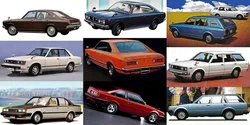

Toyota Carina Generation 3 A60 Overview
Discover the Toyota Carina, especially the Generation 3 A60 model. Explore its features, specifications, and how this iconic car stands out in Portugal.
The Toyota Carina Generation 3, commonly referred to as the A60, represents a pivotal stage in the lineage of this compact family car. Introduced in 1982 and produced until...
Technical Specifications
Select Version
Dimensions
Engine
Driving
Others
History and Features
Mycarro AI
Apr 27, 2025
Introduction to the A60 Generation
The Toyota Carina Generation 3, commonly referred to as the A60, represents a pivotal stage in the lineage of this compact family car. Introduced in 1982 and produced until 1988, the A60 series highlighted Toyota's commitment to blending innovation with practicality. It was a response to the increasing demand for reliable and efficient vehicles during a period marked by economic fluctuations and changes in consumer preferences.
Design and Features
The Carina A60 showcased a more modern and aerodynamic design in contrast to its preceding models. With a sleeker silhouette and softer lines, the model gave off a sense of sophistication that appealed to a broad demographic. The interior was both spacious and functional, designed with the priorities of comfort and utility in mind. Seating for five was standard, and the materials used provided a feeling of quality, a hallmark of Toyota's engineering ethos.
Technology features were fairly advanced for its time. Depending on the trim level, owners could enjoy items such as power windows, a higher-end audio system, and air conditioning – options that set the Carina apart from many competitors in the market. Additionally, the dashboard layout was intuitive, making it easy for drivers to remain focused on the road while easily accessing controls.
Engine Variants and Performance
Under the hood, the A60 offered various engine configurations to suit diverse driving preferences. The range typically included both four-cylinder petrol engines and a diesel variant, ensuring that buyers had several options to choose from. The most popular engines were the 1.6-liter and 1.8-liter petrol engines, which provided a balance of sufficient power and commendable fuel efficiency.
Many driving enthusiasts appreciated the Carina’s respectable handling capability. Although this was not a performance-oriented car per se, it managed to deliver a confident driving experience. The suspension system was tuned to handle city and highway driving effectively, allowing for a smooth ride with minimal road noise.
Safety Features
As the automotive industry continually evolves, safety concerns become paramount. The Carina A60 incorporated several safety features to enhance occupant protection. While some advancements today may seem standard, during the A60's time, options such as anti-lock brakes (ABS) and improved crumple zones were considered cutting edge.
The vehicle was built with a sturdy body structure that could absorb impact energy. While it did not receive the highest safety ratings by modern criteria, it was regarded as a reliable vehicle in terms of crash safety, which was becoming increasingly important to consumers then.
Market Impact and Sales
The Carina A60 was met with a warm reception in various global markets, quickly becoming a preferred choice among families and individuals alike. Its reputation for reliability and low operating costs made it an attractive alternative to other compact cars of the era.
Sales figures during its production run were impressive, contributing significantly to Toyota's market share in the compact car segment. The A60's versatility allowed it to cater to different markets, whether in urban environments or rural areas, further cementing its position as a popular choice.
Conclusion
The Toyota Carina Generation 3 (A60) stands out as a noteworthy chapter in Toyota's history. It expertly combined practicality, reliability, and technological advancements during a transformative time for the automotive industry. While it might not be as iconic as some other models in Toyota's lineup, the A60 laid a solid foundation for future generations of the Carina, leaving an indelible mark on the compact car landscape. Its legacy remains celebrated among car enthusiasts and collectors who appreciate its significance in shaping modern automobiles.
